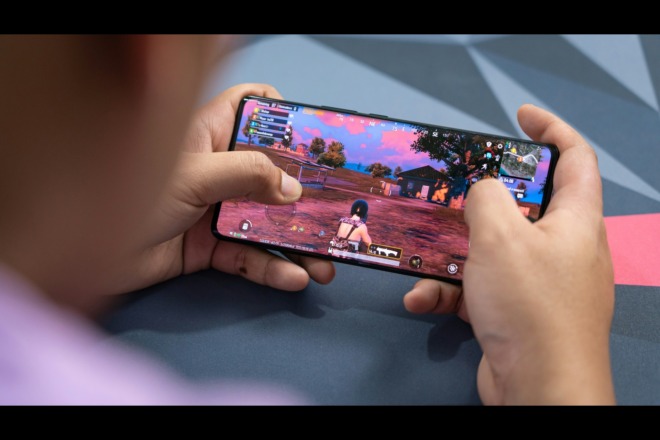Many people who create an app assume users will discover it through Google Play or Apple’s app store. However, the chances are less likely, especially since there are around 2 million apps in each app store today.
That’s why you need a robust marketing campaign to help launch the discovery of your app — because no matter how intriguing or entertaining it might be — most people will have trouble seeing it without a well-designed app landing page.
So, if you’re going to promote your mobile app, here are some best practices to designing a stellar app landing page.
Designing a Mobile App Landing Page
1. Start with a Conversion Goal
What main action do you want your users to take with the app landing page? Some can be as simple as including a direct link to the Android or iOS app stores for users to download. Others might want their customer to subscribe to a service first. Or they might have to purchase a physical product to use the app.
Whichever your conversion goal might be, make sure it has a significant impact through the design, copy and calls-to-action (CTA).
2. Create the Mobile Version First
You might be keen first to design your new app landing page for the desktop. However, apps are designed for smartphones and tablets. So, it makes sense to start with the mobile version design. This strategy works because many users looking for a new app to download are on their smartphones. So, you’re setting yourself up for more downloads of your app.
3. Maintain Attention
Mobile app pages benefit better when you encourage a direct download at the top of the landing page. So, instead of overwhelming them with loads of information, give them essential information first to convert.
4. Form the Headline
The first thing the viewer will see on the app landing page is the headline. This part is highly significant as it communicates the value of your app. You don’t need to be crafty or witty, but you do need to state the purpose of what your app does for the reader. Or it can at least be intriguing enough for them to stay on the landing page.
You’ll also want to make sure you’re working in keyword phrases into the headline. That way, you can increase the likelihood of your audience clicking on the link when searching for a solution to their problem.
5. Add the Call-to-Action
This part of the app landing page supports your conversion goal. It should be a button that sends them to the app store so they can click to download. Or it could be a contact or subscription form to get the app directly.
A call-to-action can also come in many other forms, such as a text link. The CTA is the most imperative element of the page as it can turn a casual reader into a lead.
6. Write the Body Copy
The body copy is the part that will expand your value proposition and benefits. The copy should answer all of the reader’s questions and connect with them emotionally — satisfying why they came to your app landing page in the first place.
How long your copy will be can depend on your industry — but as stated previously, you’ll want to give them the essential information upfront to attract attention.
7. Provide Social Proof
Social proof establishes the fact that your app is trustworthy. In most cases, an app landing page will showcase top user reviews and customer testimonials. Some will also display the app’s rewards and big-name sites that feature it. Another way to add social proof is to boast about the number of active users and downloads.
8. Integrate Media
Visual elements play a leading role in the app landing page. You want to be sure you’re choosing images and video elements that add delight and attract the user’s attention. However, the goal is not to build a beautiful app landing page. With visuals, the intent is to enhance the story your copy is communicating to make it compelling and engaging for the reader.
Best Practices to Consider When Designing Your App Landing Page
Keep Text Short and Concise
Because people have short attention spans these days, it’s best to keep your body copy sharp and straight to the point. You’ll also want to consider the readability factor in your app landing page. For example, you can consider adding bullet points to drive the essential information.
Furthermore, you want to keep the language as simple as possible. It’s best to avoid all that jargon if you’re advertising a non-technical product or service.
Incorporate Legible Text
Nothing might be more frustrating to readers when they can’t read text on their mobile devices. To ensure your text is readable, utilize a larger text size. The proper font size in mind is to make it large enough for readers to see it at arm’s length.
For instance, a header text can be a larger size to make a point of the app extra clear. That way, your audience will grasp the benefit of the app at first glance.
Design for Finger-Tapping
With mobile app landing page designs, your tapping points must provide sufficient space not to overlap each other.
For example, if you have various download links, they should be large enough so that it’s easy to click on for mobile users.
Make It Lightening Fast
It can be tempting to encourage users to click around to show off lots of features. However, a slow post-click experience will elicit lots of frustration. According to Google, mobile site visitors are 123% more likely to bounce when the load time increases to 10 seconds. As frustration incurs for users, this will impact your conversion rate.
Boost your load speeds with Accelerated Mobile Pages (AMP), so people can see your content and convert.
Make It as Simple as Possible to Click the CTA Button
The CTA button should be one of the highlights of your app landing page. If users can’t find where to download your mobile app, you’ll decrease the chances of converting. So, if you have copy on your landing page, avoid making them sift through endless scrolling.
The simplest landing page will show you what the product looks like, then ask the reader to download it.
Drive Intent to Download the App
Explaining the benefits and the problem your app solves will showcase the value of your app. You’ll convert the customer sooner if you can sell early on the app landing page. Remember though, simple is best.
Some apps will explain the value a user gets from the app. Then they’ll present a simple process for how they can start using the app immediately.
Offer a Free Alternative
App landing pages are successful when they provide readers with two options — a paid subscription and a free version. When onboarding users with a free trial, this does a couple of things. First, the user gets to experience the app before they buy. Second, it nurtures the potential customer before converting into a paid subscriber.
Optimize Your App Landing Page With Design
The design of your app landing page can play a large role in engagement and conversion. However, you want to create your design around the intention of the landing page — which is to get visitors to download your app. If your pages aren’t converting well, keep testing your page’s elements to determine what’s working for your audience.
About The Author
Eleanor Hecks is the Editor-in-Chief of Designerly Magazine, an online publication dedicated to providing in-depth content from the design and marketing industries. When she's not designing or writing code, you can find her exploring the outdoors with her husband and dog in their RV, burning calories at a local Zumba class, or curled up with a good book with her cats Gem and Cali.
You can find more of Eleanor's work at www.eleanorhecks.com.


